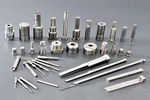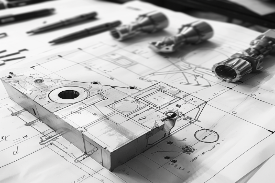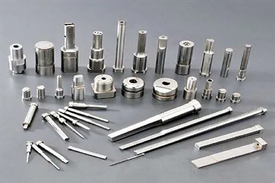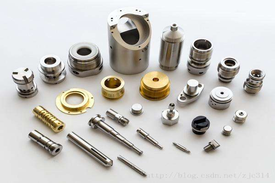CNC Machining
Home > CNC Machining
Our extensive range of precision-machined components is engineered to deliver consistent performance and reliability across your most demanding industrial applications. Every part is crafted to meet tight tolerances, ensuring seamless integration into your production line and long-term operational efficiency—because your equipment’s performance depends on the quality of its components.
Your Reliable Source for Machined Metal Parts
some products
OEM CNC Machining for Every Venture

cnc part

Spare part

heat sink

CNC Machining Part

spare part

metal sheet

Custom CNC Machining for Your Unique Projects
- Engineering Collaboration: Work with our team using advanced CAD/CAM tools to refine designs for manufacturability, ensuring your parts are both functional and cost-effective to produce.
- Rapid Prototyping: Test concepts with precision prototypes before full-scale production, validating fit, form, and function to avoid costly revisions later.
- Diverse Machining Capabilities: Leverage CNC turning, milling, drilling, and grinding to produce complex geometries in metals, plastics, and composites—no matter how intricate your specifications.
- Comprehensive Finishing: Enhance performance and aesthetics with post-processing options like anodizing, plating, coating, and heat treatment, tailored to your application’s demands.
Let’s Navigate Your CNC Machining Needs
Custom CNC machining involves a lot of details, which is why we’ve packed this page with the insights you need. To help you find what matters most quickly, we’ve organized key sections into a simple table of contents—just click a link to jump straight to the information you’re after.
General Applications For CNC Machining
- Aerospace: Produces critical engine components, structural frames, and avionics parts where tight tolerances and material reliability are non-negotiable for safety and performance.
- Automotive: Manufactures precision parts like engine valves, transmission components, suspension hardware, and chassis fittings—ensuring durability under extreme operating conditions.
- Medical Devices: Creates surgical instruments, orthopedic implants, and dental tools that meet strict hygiene standards and require micron-level accuracy for patient safety.
- Electronics: Fabricates connectors, heat sinks, and precision metal components for smartphones, computers, and industrial electronics—supporting miniaturization and thermal efficiency.
- Energy: Builds robust parts for oil drilling equipment, wind turbine systems, solar panel hardware, and nuclear components—designed to withstand harsh environmental stress.
- Defense & Military: Delivers high-performance parts for firearms, armored vehicles, and aerospace systems where reliability and ruggedness are critical for operational success.
- Heavy Machinery: Produces gears, pumps, valves, and transmission systems for industrial equipment—engineered to handle heavy loads and continuous operation.
- Consumer Goods: Crafts high-end components for watches, cameras, musical instruments, and jewelry—combining functional precision with aesthetic appeal.
- Construction: Supplies structural metal fittings, custom brackets, and decorative elements that balance strength with design flexibility.
- Transportation: Manufactures key parts for trains, ships, and logistics equipment—ensuring smooth operation and longevity in high-use scenarios.
Main Process for CNC Machining
CNC machining transforms raw materials into precision components through controlled cutting, shaping, and finishing—tailored to your material type, tolerance requirements, surface finish needs, and production volume. Success depends on optimizing cutting speeds, feeds, and depths to balance efficiency, quality, and tool longevity. Here’s how the process unfolds:

Preparation
- Tooling & Fixturing: Select specialized tools, gauges, and fixtures matched to your material and design, ensuring secure workpiece positioning and consistent results.
- Programming: Develop CNC codes that dictate tool paths, cutting parameters, and sequence—translating your CAD designs into machine-executable instructions for precise replication.

Roughing
- Goal: Rapidly remove excess material to establish the part’s basic shape, bringing it close to final dimensions.
- Approach: Use larger tools and aggressive cutting parameters to maximize material removal, prioritizing speed over fine precision at this stage.
Equipment: Standard lathes, mills, or CNC machining centers handle the bulk material removal efficiently.

Intermediate Machining
- Goal: Refine dimensions and begin shaping critical features, narrowing in on final specifications.
- Approach: Adopt more conservative cutting parameters (speed, feed, depth) to improve accuracy. Specialized tools target detailed features like holes, slots, or steps, with tailored strategies for delicate elements (e.g., thin walls, high-precision bores).
Equipment: Same core machinery as roughing, but with stricter tool selection and parameter controls to enhance precision.

Finishing
- Goal: Achieve exact dimensional accuracy and desired surface quality, meeting all design requirements.
- Approach: Use sharp, high-precision tools with tightly controlled cutting conditions to deliver final tolerances and smooth surfaces. For ultra-precise parts, secondary processes like grinding or polishing may be added.
- Inspection Focus: Every feature and surface is checked to ensure alignment with design specs before moving to quality control.
Equipment: Specialized grinders and finishing machines complement lathes and mills for premium results.

Inspection and Quality Control
- Dimensional Checks: Verify size and geometry using calipers, gauges, and coordinate measuring machines (CMMs) to confirm compliance with drawings.
- Surface Evaluation: Inspect for roughness, defects, or inconsistencies that could impact performance or aesthetics.
Functional Testing: When required, conduct performance trials to ensure parts operate as intended in their end application.
Estimated Cost Analysis For CNC Machining
Your project’s final cost hinges on custom specifications, raw material grades, regional regulations, and shipping logistics. To provide clarity, here’s a breakdown based on typical scenarios:

This covers key cost drivers: Raw Materials: Premium metals, plastics, or composites selected to match your strength, durability, or conductivity requirements. Machining Time & Labor: Precision programming, setup, and operation of CNC equipment, scaled to part complexity. Tolerance & Complexity: Tighter tolerances (±0.01mm or better) and intricate geometries that require specialized tooling or multi-axis machining. Overhead & Quality Assurance: Facility operations, tool maintenance, and in-process inspections to ensure compliance with your specs. Volume Efficiency: Economies of scale that reduce per-unit costs for high-volume runs, offsetting initial setup expenses.
$2,300
When shipping to destinations like the U.S., freight costs are influenced by route distance, current fuel prices, vessel capacity, and global shipping trends. These variables create natural price fluctuations, but upfront quotes will account for current market conditions to help you budget accurately.
$1,300
When shipping to destinations like the U.S., freight costs are influenced by route distance, current fuel prices, vessel capacity, and global shipping trends. These variables create natural price fluctuations, but upfront quotes will account for current market conditions to help you budget accurately. Additional Project Costs Customs Duties & Taxes: Calculated based on your destination’s tariff codes and trade agreements—we provide HS code guidance to streamline compliance. Transit Insurance: Protect your shipment against damage or loss with flexible coverage options tailored to your order’s value. Warehousing: Short-term storage fees if staging is needed upon arrival, with transparent pricing for extended holding if required. Last-Mile Logistics: Inland transportation (trucking, rail) and terminal handling charges at the destination port, coordinated to align with your production timeline.
$1,000The Process Flow & Duration Estimation
Your project timeline depends on design complexity, material availability, order volume, quality control requirements, and potential adjustments. Here’s a clear breakdown to help plan your production schedule:.
Step 1: Engineering Design & DFM Planning (3-7 days)
This phase involves creating detailed engineering drawings, selecting optimal materials, and defining machining methods tailored to your part’s functionality and durability. Using advanced CAD/CAM software, 3D models and simulations identify potential structural or manufacturing issues early—reducing costly revisions later. Collaboration between design and manufacturing teams ensures feasibility, with design reviews streamlining the process to align with production capabilities.

Step 2: Prototyping & Validation (7-14 days)
Turn designs into tangible prototypes to test fit, function, and performance. Physical testing (load, durability, and usability trials) validates whether the part meets your operational needs. This stage allows for tweaks to refine dimensions, material choices, or machining approaches—critical for ensuring bulk production runs smoothly.

Step 3: Payment Confirmation (within 1 day)
Finalize payment terms—whether deposits, progress payments, or final settlement upon sample approval—to keep production on track. Clear agreement on terms ensures no delays once prototypes are approved.

Step 4: bulk Production (30-45 days)
With prototypes validated, full-scale manufacturing begins. This phase includes material procurement, tooling setup, and optimized production scheduling to avoid downtime. In-process inspections (first-article checks, ongoing quality sampling) ensure consistency, while efficient workflow management handles volume demands—whether small batches or large-scale orders.

Step 5: Shipping & Logistics (10-45 days)
Choose between sea, air, or land transport based on your timeline, budget, and shipment size. Custom packaging (tailored to part weight, shape, and material) prevents damage during transit. Coordination with logistics partners ensures smooth customs clearance, with proper documentation to avoid delays at borders.

Want to Slash Your CNC Machining Lead Times?
- Faster Turnaround: Advanced technology and optimized workflows reduce lead times by up to 30% compared to standard industry timelines.
- Tailored Solutions: Complex designs or tight specs? We craft custom processes to meet your exact requirements, no shortcuts.
- Transparent Communication: Stay in control with real-time updates from initial consultation to delivery—no surprises, just clarity.
The Basic Knowledge About CNC Machining
CNC machining forms the foundation of modern manufacturing, enabling precise, automated control of complex machinery to deliver consistent results across industries.
- Complex Geometry: Achieve intricate shapes and tight tolerances that manual machining can’t match, opening up design possibilities for your most demanding projects.
- Efficiency: Reduce production time and material waste through automated processes, lowering costs without compromising quality.
- Material Versatility: Work with metals (aluminum, steel, titanium), plastics, and composites—adapting to your application’s unique requirements, whether for strength, weight, or corrosion resistance.
- Scalability: Seamlessly transition from small-batch prototypes to high-volume production runs, ensuring your supply chain keeps pace with demand.
The Common Pitfalls When Purchasing
Sourcing machined parts requires careful navigation to avoid costly mistakes that compromise quality, delays, or performance. Here are critical pitfalls to watch for—and how to steer clear of them:
- Chasing Unrealistically Low Prices
- Communication Gaps in Technical Requirements
- Overlooking Supplier Technical Capabilities
- Inadequate Quality Assurance Protocols
- Unreliable Delivery Schedules
- Lack of Post-Delivery Support
A Brief Self-Nomination, Why Choose Jiaen MFG?
When you need custom machined parts that balance precision, reliability, and efficiency, Jiaen MFG delivers a one-stop solution tailored to your operational demands. Whether you’re scaling production or prototyping complex components, you’ll gain a partner equipped to meet your unique requirements—no minimum order constraints, just consistent quality that keeps global enterprises and tech leaders coming back.
- Diverse Processing Capabilities: From CNC turning and milling to advanced EDM and grinding, we handle materials ranging from metals to composites, covering even your most specialized part geometries.
- Advanced Production Facilities: State-of-the-art equipment ensures tight tolerances (up to ±0.001mm) and repeatable results, critical for industries where precision directly impacts performance.
- Stringent Quality Control: Every part undergoes multi-stage inspections—from material certification to CMM verification—ensuring compliance with your specs and industry standards.
- Customization Expertise: Our team translates your CAD designs into manufacturable solutions, offering DFM insights to optimize functionality while reducing costs.
- Flexible Production Capacity: Whether you need 10 prototypes or 100,000 production units, we scale seamlessly to meet your deadlines without compromising quality.
- Experienced Technical Team: Engineers with deep industry knowledge collaborate with you to solve challenges, from material selection to process optimization.
- Comprehensive After-Sales Service: We stand behind our work with responsive support, handling rework, troubleshooting, and warranty claims to keep your operations on track.
- Proven International Experience: With a track record of serving global clients, we navigate logistics, compliance, and communication seamlessly—so you avoid cross-border headaches.
The FAQs About CNC Machining
Navigating CNC machining procurement requires clarity on critical factors that impact your project success. These FAQs address key questions to help you make informed decisions—covering supplier selection, quality assessment, pricing, lead times, and logistics. Whether you’re sourcing locally or globally, the insights here will help you secure high-quality machined parts, optimize costs, and strengthen your supply chain efficiency.
How do I determine the right material for my CNC machined parts?
Material selection depends on your part’s function: aluminum offers lightweight strength for aerospace or automotive uses; stainless steel provides corrosion resistance for industrial or medical applications; titanium suits high-temperature environments like aerospace engines. Consider factors like load requirements, operating conditions, and cost targets—ask suppliers for material recommendations based on your specific use case.
What tolerances can I expect from CNC machining, and how do they impact cost?
Typical tolerances range from ±0.01mm for precision components to ±0.1mm for general parts. Tighter tolerances (e.g., ±0.005mm) require advanced equipment and slower production speeds, increasing costs. Discuss your functional needs with suppliers—over-specifying tolerances can drive up expenses without adding value, while under-specifying may compromise performance.
How can I verify a supplier’s CNC machining capabilities before placing an order?
Request a technical audit: review their equipment list (e.g., 5-axis mills, precision lathes), quality certifications (ISO 9001, IATF 16949), and case studies of similar parts. Ask for samples to inspect surface finish and dimensional accuracy. A reputable supplier will share process documentation and allow virtual or on-site facility tours.
What’s the difference between prototyping and production runs in CNC machining?
Prototyping focuses on validating design fit and function, using faster setups and smaller batches (1–50 units) with lead times of 7–14 days. Production runs prioritize efficiency for large volumes (100+ units), with optimized tooling and longer lead times (30–45 days) to reduce per-unit costs. Suppliers often offer scaled pricing for larger orders.
How do design complexities affect CNC machining costs and lead times?
Complex geometries—like deep cavities, thin walls, or intricate threads—require specialized tooling, multiple setups, and slower cutting speeds, increasing both cost and production time. Simplifying designs (e.g., standardizing radii, avoiding sharp internal corners) can reduce expenses. Work with suppliers on design for manufacturability (DFM) reviews to optimize complexity.
What quality inspections should I require for CNC machined parts?
Mandate dimensional checks using coordinate measuring machines (CMMs) for critical features, surface finish reports (Ra values), and material certification (COA) to confirm alloy composition. For high-risk applications, add destructive testing (e.g., tensile strength) or non-destructive testing (e.g., ultrasonic inspection) to catch hidden defects.
How do international shipping and customs impact CNC machining orders?
Lead times extend by 10–45 days for sea freight or 3–7 days for air freight, depending on destination. Factor in customs clearance time—ensure suppliers provide accurate HS codes, commercial invoices, and material declarations to avoid delays. Discuss packaging requirements (e.g., anti-corrosion coatings, secure crating) to prevent damage in transit.
What post-processing options are available for CNC machined parts, and when should I use them?
Options include anodizing (for corrosion resistance on aluminum), heat treatment (to harden metals), powder coating (for durability and aesthetics), and plating (e.g., nickel for conductivity). Choose post-processing based on your part’s environment: outdoor parts benefit from weather-resistant coatings, while medical parts may require biocompatible finishes like passivation.














